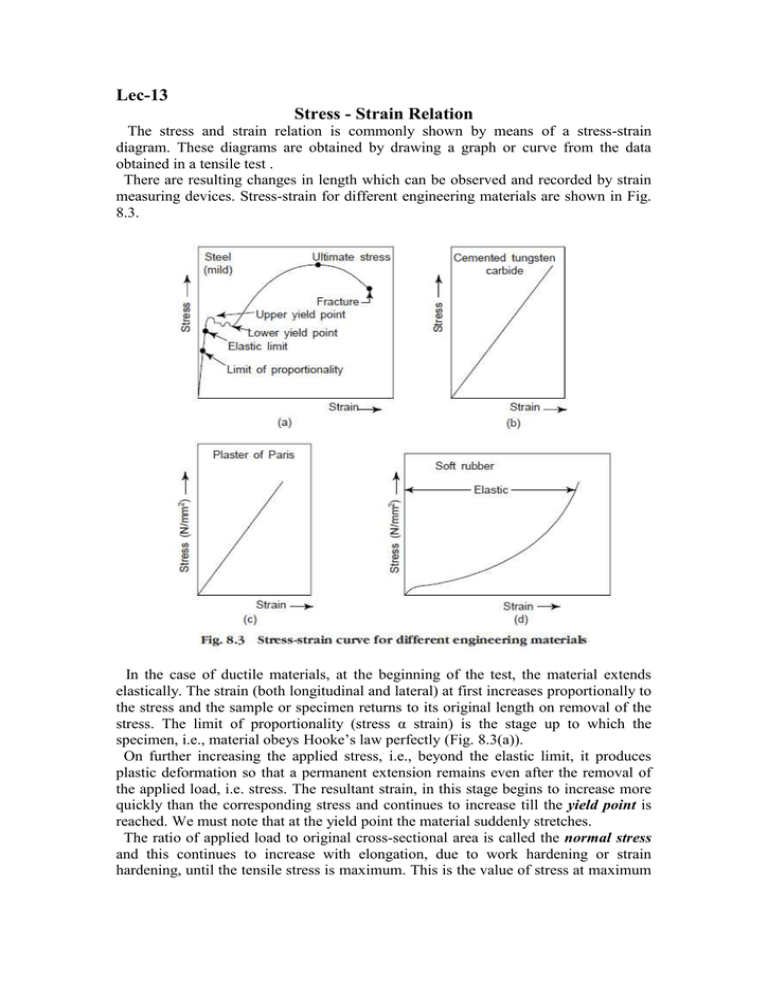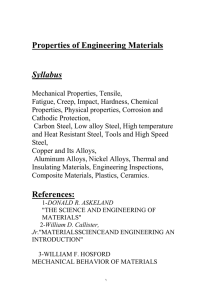Lec-13 Stress - Strain Relation
advertisement

Lec-13 Stress - Strain Relation The stress and strain relation is commonly shown by means of a stress-strain diagram. These diagrams are obtained by drawing a graph or curve from the data obtained in a tensile test . There are resulting changes in length which can be observed and recorded by strain measuring devices. Stress-strain for different engineering materials are shown in Fig. 8.3. In the case of ductile materials, at the beginning of the test, the material extends elastically. The strain (both longitudinal and lateral) at first increases proportionally to the stress and the sample or specimen returns to its original length on removal of the stress. The limit of proportionality (stress α strain) is the stage up to which the specimen, i.e., material obeys Hooke’s law perfectly (Fig. 8.3(a)). On further increasing the applied stress, i.e., beyond the elastic limit, it produces plastic deformation so that a permanent extension remains even after the removal of the applied load, i.e. stress. The resultant strain, in this stage begins to increase more quickly than the corresponding stress and continues to increase till the yield point is reached. We must note that at the yield point the material suddenly stretches. The ratio of applied load to original cross-sectional area is called the normal stress and this continues to increase with elongation, due to work hardening or strain hardening, until the tensile stress is maximum. This is the value of stress at maximum load and one can calculate it by dividing the maximum load by the original crosssectional area. This stress is called ultimate tensile stress (Fig. 8.3(a)). From Fig. 8.3(a) it is evident that at a certain value of load the strain continues at slow rate without any further stress or loading. This phenomenon of slow extension increasing with time, at constant stress, is termed creep. A neck begins to develop at this point, along the length of the specimen and further plastic deformation is localized within the neck. The cross-sectional area decreases in proportion to the increasing length during elastic elongation. We must note that the volume of the test bar, i.e. specimen remains constant. Figure 8.3(a) is a stress-strain diagram for mild steel. This diagram clearly shows the limit of proportionality, elastic limit, yield point, ultimate tensile stress and fracture stress at the breaking points. We note that this diagram shows a well-defined yield point. Poorly defined yield point as in the case of brittle materials is shown in Fig 8.4. For the determination of the yield strength in such materials, following the general practice, one has to draw a straight line parallel to the elastic portion of the stressstrain curve at a predetermined strain ordinate value (say 0.1%). The point at which this line intersects the stress vs. strain curve is the yield point at off-set and called the yield strength at 0.1% or 0.2% of set strain. Stress vs. strain curves also help to explain the properties of ductile materials. We find that: ♣ Greater the angle of inclination of the line of stress vs. strain proportionality to the ordinates, the more elastic is that metal. ♣ A higher yield point reveals greater hardness of the metal. ♣ A higher value of the maximum stress point shows that the metal is a stronger one. ♣ The toughness and brittleness of metal are indicated by the distance from the ordinates of the breaking stress or load point. The metal is more brittle when the distance is shorter. Engineering and True Stress-Strain Diagrams: When we calculate the stress on the basis of the original area, it is called the engineering or nominal stress. If we calculate the stress based upon the instantaneous area at any instant of load it is then termed as true stress. If we use the original length to calculate the strain, then it is called the engineering strain. Now, we have : (ix) Brittleness: It may be defined as the property of a metal by virtue of which it will fracture without any appreciable deformation. This property is just opposite to the ductility of a metal. Ex: cast iron, glass and concrete. This property of metals find its importance for design of machine tools, which are subjected to sudden loads. Metals with less than 5% elongation are known to be brittle ones. (x) Toughness: It may be defined as the property of a metal by virtue of which it can absorb maximum energy before fracture takes place. Toughness is also calculated in terms of area under stress-strain curve. Toughness is the property of materials which enables a material to be twisted, bent or stretched under a high stress before rupture. The value of toughness falls with the rise in temperature. Toughness is highly desirable property for structural and mechanical parts which have to withstand shock and vibration. (xi) Stiffness: This may be defined as the property of a metal by virtue of which it resists deformation. Modulus of rigidity is the measure of stiffness. The term flexibility is quite opposite of stiffness. The materials which suffer less deformation under load have high degree of stiffness. (xii) Resilience: This may be defined as the property of a metal by virtue of which it stores energy and resists shocks or impacts. It is measured by the amount of energy absorbed per unit volume, in stressing a material up to elastic limit. This property is of great importance in the selection of a material used for various types of springs. (xiii) Endurance: This is defined as the property of a metal by virtue of which it can withstand varying stresses (same or opposite nature). The maximum value of stress, which can be applied for an indefinite times without causing its failure, is termed as its endurance limit. For ordinarily steel, the endurance limit is about half the tensile strength. This property of a metal is of great importance in the design and production of parts in a reciprocating machines and components subjected to vibrations. Anelastic Behaviour: Recoverable deformation that takes place as a function of time is termed anelastic deformation. Due to some relaxation process within the material, the elastic deformation of the material continues even after the application of the load. On removal of the load, some part of the elastic deformation is recovered only as a function of time, with the reversal of the relaxation process. Viscoelastic Behavior: This is found in those materials which respond to an applied stress by both recoverable and permanent deformations, which are time dependent. Non-crystalline organic polymers exhibit this behaviour. Time dependent permanent deformation is termed as viscous flow. We may note that it is analogous to the creep phenomenon in crystalline materials.







